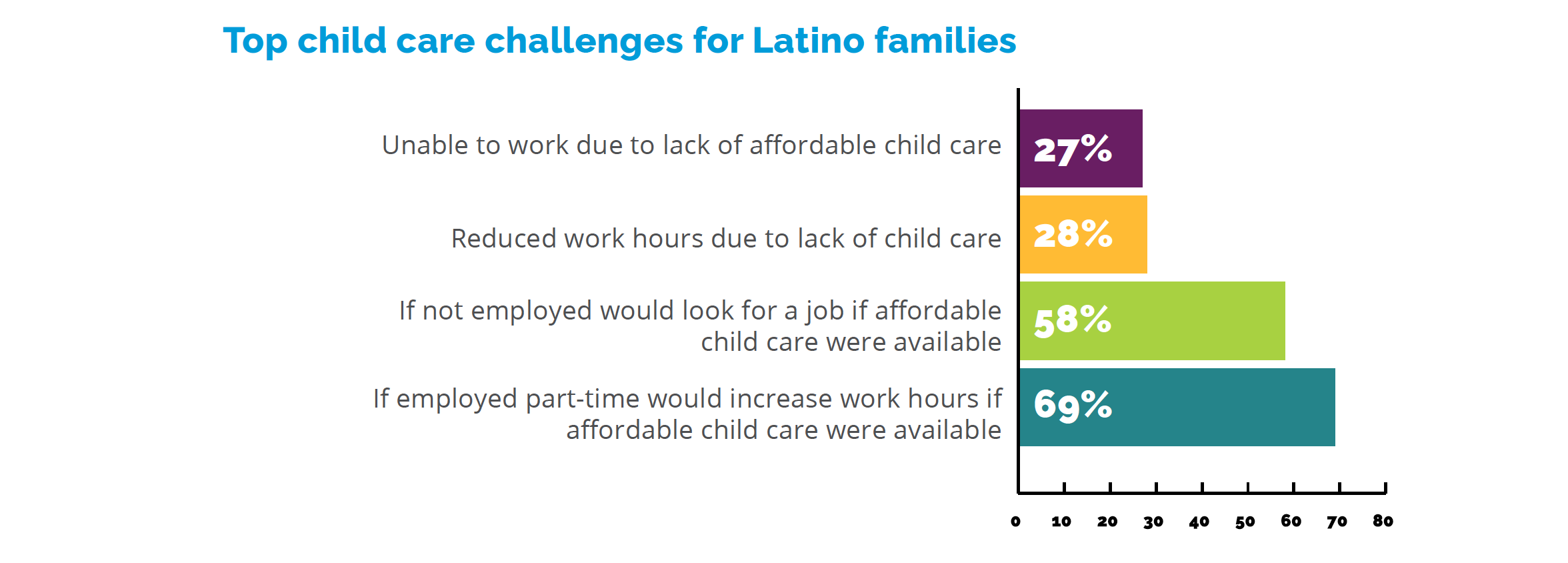

Cyntia Flores doesn’t compromise when it comes to parenthood. Her world revolves around her two children, Camila, four years old, and Karim, eight months old.
Over the past year, Cyntia has interviewed and visited at least 10 different child care centers near her home in Riverside, California. She finally found a center in her area that checks all of the boxes, but it wasn’t easy.
Being an immigrant to the United States, and only eight months postpartum is enormously challenging. However, she has never backed down from giving her children the best care possible. Staying persistent and trusting her instincts has rewarded her with the best child care that she can afford in her area.
“I understand child care is a lot of time, a lot of care, a lot of responsibility. But at the same time, the prices are sky high. It's too much money. It's too much,” she says. “This has been one of the biggest barriers.”
Cyntia is not alone. Finding affordable, quality child care has become nearly impossible for families across the United States.
A Daunting Search
According to the 2024 National Latino Family Report, 51% of families do not receive child care and 34% say they can’t afford it.
Child care costs have increased 28% over the last decade, and low-income families are more likely to feel the strain. The average cost of child care for families making less than $75,000 was greater than 7% of household income. The most recent Census data show about 43% of families with children earn less than that annually.
Cyntia, who moved to the U.S. from El Salvador, doesn’t have familial support in the United States. Apart from her husband, José, there is no other family to help with child care. From the National Latino Family Report, we know that 87% of Latino families prefer care to be provided by a family member, but for Cyntia this is not an option.
It was a daunting task weeding through all of the different child care centers. To find the right fit, Cyntia spent hours reading reviews, judging ratings, making phone calls, and doing drop-in visits.
Finding reliable information was an uphill battle. She warns, “If you make an appointment, everything is going to be clean, everyone is going to be smiling.” In order to better understand how the center operates, “I don't make an appointment, I come in unexpectedly. Then I see the real world, which is what I can expect on a daily basis.”
For her son Karim, who is only eight months old, it has been more difficult to gauge his experience. "He’s still too young to really know. But as a parent, you can tell if your child doesn't want to go to a place, if they feel uncomfortable,” she says. “That's where I'm having difficulty because he doesn't talk. He can't tell me ‘they didn't feed me,’ or ‘I was crying.’ That's what worries me the most.”
Cyntia looked for five key qualities in a childcare center: trust, communication with parents, bilingual education, patience, and affordability.
“It is important that they have patience, because children require a lot of time,” Cyntia says. She wanted caregivers who were “dedicated to love, not to money”.

Finally, after months of searching, Cyntia is relieved to have found a daycare she loves, Centro de Niños Nati Fuentes in Riverside, California.
"It gives me peace of mind, as a parent, that's key," she says.




Benefits of Quality Care
After only a few months at the child care center, Cyntia has seen benefits for both herself and her children.
“For Camila, I have seen great progress. She already knows the colors, numbers, how to write her name,” says Cyntia. “And she was very shy. Now with the other children, she gets to learn to share, learn how to develop. I have seen that she has evolved quite well.”
Early childhood experts recognize the prenatal to three-year period as crucial for development. A report published by National Bureau of Economic Research found that, “early experiences during this time shape the brain’s architecture and have long-lasting effects on learning, behavior, and health.” The report shows that access to high-quality early childhood services correlates with improved academic success, educational attainment, future earnings, well-being, and reduced crime rates.
In a 2023 report published by Abriendo Puertas/Opening Doors and UnidosUS, the Latino Infant Initiative Policy Agenda urged, “prioritizing and investing in children and families during this period maximizes every child’s potential.”
Additionally, access to child care can unlock greater economic security and opportunity for Latino families like Cyntia’s.
The Center for American Progress states access to affordable, high-quality child care will have a direct effect on the economy. Their research finds more take-home income for families that can be used for food, education, debt payments, and savings and contribute to more jobs, inclusive economic recovery, and growth.
The availability and affordability of care directly affects employment decisions and the economic stability of working families. According to the National Latino Family Report, 69% of parents say they would increase their work hours if affordable child care was available, and 58% would be more likely to look for a job.

Cyntia currently works as a school bus driver. She said finding a child care center that would accommodate her work schedule was one of the hardest parts of her search. Instead of driving around worrying about the child care situation, she now feels more at ease.
Cyntia can now explore taking on more work hours or other job opportunities, “now that I know my children are safe, protected, and in a good place."
How the Government Can Help
In Cyntia’s view, the government can help families like hers by increasing awareness of existing child care assistance programs, and raising the income level for assistance.
“The reality nowadays is that the cost of living is too high,” she says. “The government should also take into account that you have to pay rent. I can barely afford the monthly payment for one child. I applied for more assistance, and they are going to give me a certain amount, but I’m still waiting to be approved.”
The American Rescue Plan Act increased the child tax credit, which helped relieve the child care cost burden during the pandemic. A report from the Congressional Research Service found the program to be exceptionally successful, providing families in the lowest 20% of income with the largest benefit. However, the expanded payments expired at the end of 2021.
"In California it is difficult, because I don’t qualify as low-income,” says Cynthia. “The daycare costs $395 a week for one child, but I still don't qualify for the subsidy.”
According to the National Latino Family Report, Latino families strongly advocate for increased state investment in affordable child care. This includes expanding programs like Head Start, with 89% of families favoring more funding to make these programs more affordable or free.

Additionally, 91% of families advocate for increased funding for parent and family engagement programs, recognizing the vital role of family involvement in early learning.
Although motherhood is full of hardships—it’s also full of joy. Cyntia has big dreams for her family's future stability, security, and health.
Her joy for being a mother drives her stamina to never compromise for her children’s care. “Knowing that they are healthy, happy children and that I try to give them the best life possible—that's what gives me joy,” she says.
With access to affordable, high-quality childcare, families like Cyntia's can thrive, and Latino children can grow up happy, healthy, and ready to reach their full potential.
Most of all, Cyntia says, “I want my children to have beautiful memories. I want them to play and live day by day to the fullest. I want them to know that they are very loved.”


